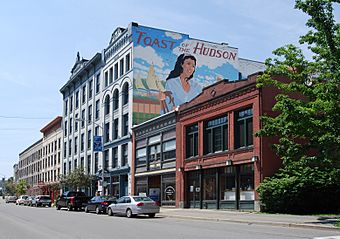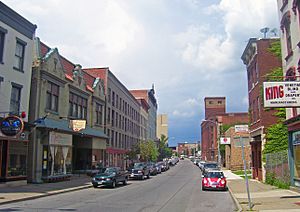Northern River Street Historic District facts for kids
Quick facts for kids |
|
|
Northern River Street Historic District
|
|

Looking southwest from the corner of Jacob and River Streets
|
|
| Location | Troy, NY |
|---|---|
| Area | 2 acres (8,000 m²) |
| Built | ca. 1840-1910 |
| Architectural style | Greek Revival, various other contemporary styles |
| NRHP reference No. | 88000630 |
| Added to NRHP | 1988 |
The Northern River Street Historic District is a special area in Troy, New York. It is located along River Street, near the Green Island Bridge. This district was added to the National Register of Historic Places in 1988. This means its buildings are important to American history and should be protected.
The district covers about 2 acres (8,000 square meters). It includes 13 old brick buildings. These buildings were used for factories and shops from the mid-1800s to the early 1900s. They were cut off from the rest of downtown Troy by a railroad. This made the area a key spot for the city's main businesses, especially making textiles like shirt collars. Even when these businesses slowed down, the buildings stayed mostly the same. This is because new roads and city changes made the area even more separate from the city center.
Contents
What is a Historic District?
A historic district is a group of buildings, structures, or other objects that are important because of their history or architecture. When an area is listed on the National Register of Historic Places, it helps protect its unique character. This encourages people to preserve and reuse the old buildings.
Exploring the Buildings
The buildings in the Northern River Street Historic District are mostly made of brick. They show different building styles from the time they were built.
West Side Buildings
On the west side of River Street, you'll find some very old and large buildings.
- 409-415 River Street: This building is four stories tall and was built around the 1840s. It used to be a warehouse. It's the oldest building in the district. You can see old Greek Revival style details, like decorative columns, on its storefronts.
- 417-419 River Street: Built about ten years later, this building is also tall but a bit narrower. It has a similar design to its neighbor.
- 421-423 River Street: This is the Cleminshaw Building, built in 1885. It was part of the H.C. Curtis Collar Co. At five stories tall, it's the biggest building in the district. It has a fancy metal top edge with "1868 REBUILT 1884" written on it.
- 425 River Street: This five-story building from 1892 shows newer styles. It has a decorative brick top edge and rounded windows on the top floor.
- Newer Buildings: At the very north end of this row are two smaller buildings, built around 1910. These are the newest buildings in the district.
South and East Side Buildings
To the south of the large warehouses, there are smaller buildings.
- 403 River Street: This is a three-story building from the same time as the big warehouses.
- 405-407 River Street: This building was first the Gaiety Theatre in 1888. After a fire, it was rebuilt with a unique Dutch Colonial Revival style, which includes stepped gables (stair-shaped roof edges).
On the east side of River Street, there are three large, three-story brick warehouses. They were all built around 1885. Further north, at 428-430 River Street, is a two-story brick building from about ten years later.
A Look at the District's Past
The area became separate from downtown Troy in the 1830s. This happened when the Rensselaer and Saratoga Railroad was built. The railroad ran right next to Federal Street. This, along with the river's water power, made the area perfect for factories. Many of these factories made detachable shirt collars. Troy became famous for these collars, earning it a special nickname.
Over time, the collar industry and other factories in the area declined. The railroad tracks were eventually removed in the 20th century. The road was then made wider where the tracks used to be. Some buildings were changed in the 1950s to be used for different purposes. City projects in the 1960s and 70s also made the area more isolated from downtown. However, these changes also helped keep the remaining River Street buildings safe and mostly untouched.
Today, the Northern River Street Historic District is not only on the National Register, but it's also part of Troy's larger Riverfront Historic District. Special city rules are in place to protect its historic look. Many of the old buildings have been updated and now house small shops and restaurants, like the River Street Café.




